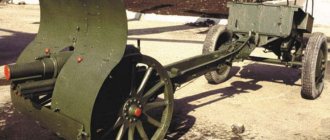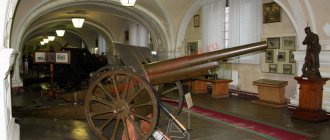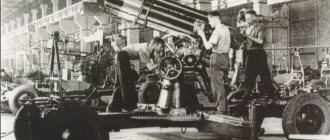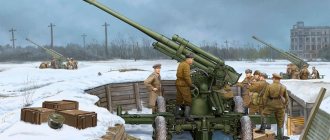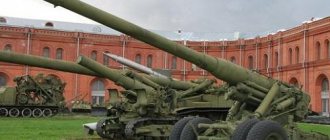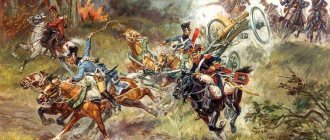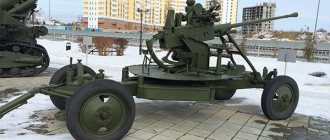Field gun
| 76-mm divisional gun model 1902 | |
| Model 1902 76 mm divisional gun at the Finnish War Museum, Helsinki, Finland. | |
| Type | Field gun |
| Place of origin | Russian Empire, USSR |
| Production history | |
| Produced | 1903-1931 |
| Characteristics | |
| Weight | combat: 1092 kg [1] (2407 lb) suspension: 2380 kg (5247 lb) |
| Barrel length | 2.28 m (7 ft 6 in) 30 gauge [2] |
| Shell | Fixed QF 76.2 x 385 mm R [3] |
| Projectile weight | 7.5 kg (17 lb) |
| Caliber | 76.2 mm (3 in) |
| Breech | Broken screw |
| Shipping | Pole trail |
| Height | -3° to 17° |
| Traverse | 5 ° |
| Rate of fire | 10-12 rpm |
| starting speed | 589 m/s (1,930 ft/s) [2] |
| Maximum firing range | 8.5 km (5.28 mi) [1] |
76.2 mm model divisional gun 1902
(Russian: 76-mm divisional gun model 1902) was a Russian light field gun used in the Russo-Japanese War, World War I, Civil War and a number of interwar armed conflicts with participants from the former Russian Empire (USSR, Poland, Finland, Estonia and etc.). Upgraded versions of this gun were used in the early stages of World War II.
History[edit]
This gun, called the “three-inch”, was developed by the Putilov plant in St. Petersburg in 1902. The leading designers were L.A. Bishlyak, K.M. Sokolovsky and K.I. Lipnitsky. It included many innovations for that time - a carriage with recoil devices, tracking mechanisms for horizontal and vertical aiming, a high-precision sight for direct and closed shooting, a manual intermittent screw bolt and integral loading of ammunition.
To simplify the mass production process, designers used cheap types of carbon steel with no or minimal use of rare and expensive steels with additions of nickel, manganese or chromium. An early version had two crew seats on either side of the barrel; from 1906 these were replaced by an armored shield. [4] The shield had a special design: an outer shield with a large rectangular hole and a smaller inner shield behind it. The upper and lower parts of the large shield were folded during transportation.
The gun had fragmentation fragments and an ammunition canister. More specialized types of projectiles included smoke, incendiary and chemical projectiles. Many ammunitions are of French origin. Limbers could carry 40 or 44 shells in light artillery and 28 shells in horse artillery, while caissons carried 48 shells in both cases. [4]
Work[edit]
Russo-Japanese War[edit]
The M1902 divisional guns were the mainstay of the artillery of the Russian Empire and were well received by the army. Their performance was on par with similar 75 mm French and German guns. The gun was first used in combat in the Russo-Japanese War at the Battle of Telissu, but proved ineffective due to lack of crew training and outdated concepts of senior artillery officers. [5]
First World War[edit]
The M1902 was also used during World War I. After the collapse of the Russian Empire in 1917, M1902 guns were used by various factions: the Bolshevik Red Army, the monarchist or counter-revolutionary White Guard, nationalist forces in Russian minority areas, the national armies of Poland and Finland, and simply anarchists and bandits in vast areas of former Imperial Russia. In some episodes, the gun was used for the first time as an anti-tank weapon. The White Guard and the intervening Allied forces used a small number of tanks, mainly French Renault FTs and British Mk V or Whippets. The M1902 gun, with its high muzzle velocity, was an effective weapon against such targets, having only bulletproof armor protection. In the Polish-Soviet War of 1920, M1902 guns were again used against Polish FTs.
German usage[edit]
7.62 cm FlaK L/30 anti-aircraft in the Brasschaat artillery museum.
Due to a string of Russian defeats during the first two years of World War I, large numbers of M1902s and their ammunition ended up in German hands. A combination of factors caused the Germans to issue the M1902 to their troops as a replacement.
These factors included:
- Underestimation of light field artillery losses in the first two years of the war and insufficient numbers of replacement guns produced.
- Underestimation of ammunition consumption, inadequate production and resulting shortages.
- Superior ballistic performance of the M1902 compared to German designs.
After German gun and ammunition production caught up during the last two years of the war, M1902s were converted to anti-aircraft guns on several different high-angle mounts, and they continued to serve in Germany until the end of the war with German ammunition. . [6]
3-inch M1903 gun
The 3-inch anti-mine guns were part of a comprehensive plan for new fortifications determined by the 1885 Fortification Board. New forts initially included guns up to 12 inches (305 mm) on vanishing wagons to conceal the fort from observers. from the sea. The 3-inch guns were the smallest of these guns, designed to protect remotely controlled minefields from minesweepers. For most of their service they were used by the United States Army Coast Artillery Corps. These were based on the 1897 Ordnance and Fortification Board requirements for weapons intermediate between the 6-pounder (57 mm) gun and the 5-inch (127 mm) gun. [4]
M1898
The M1898 was the first of the new 3-inch guns to be developed. It was manufactured by Driggs-Seabury and was fitted with a retractable M1898 "cloaking parapet" carriage. This was a proprietary term coined by Driggs-Seabury to distinguish their carriage from the similar "balanced rack" carriage of the M1897 5-inch gun, built by other manufacturers. Unlike the disappearing carriages of most larger guns, the carriage could only be retracted when the gun was at a certain rotation angle (90° from the mounting axis in most installations), thus it provided no concealment when in action. [5] Approximately 120 of these were built in 1899–1903, and at least 111 of these guns were installed in 1899–1905. [5] Gun elevation angle from -5° to + 12°; At first it was moved by pressing on the shoulder bar, and in 1904 it was modernized with a wheel-gear movement system. Initially, open luminous night sights were produced; in 1899 the Warner and Swasey M1899 Type A 3.5× telescopic sight was introduced. [6]
Official correspondence between Major Louis R. Burgess, commander of the Mobile (Alabama) Artillery District, and senior officers of the Ordnance Corps began in December 1912. This led to the identification of a number of shortcomings in the M1898 weapon, including the need to fix the elevation angle and change the traverse angle. elevation of the gun and obstruction of tracking a moving target. The rubber eyepiece on the optical sight did not fully protect against injury when fired from the weapon; Sergeant's injury. Payne of the 164th Company was noted with the remark "the side impact and vibration of the carriage during recoil is destructive to the morale of the rifleman." Lights designed for night shooting also tended to come loose, and the sight's deflection scale lamps were too bright, apparently making it difficult to see the target. Major Burgess recommended switching to the M1903 carriage and its lever firing system (as on the M1903 3-inch gun) or modifying the parapet camouflage carriage with a lateral and vertical position reduction gear. In March 1913, ordnance officers considered the possibility of disabling the carriage in the raised position by partially filling it with concrete. This had already been tested at the Sandy Hook Proving Ground and was gradually adopted for most M1898 cars as the M1898MI car until mid-1917 [7], although some had not yet been modified in March 1919. [8] Disabling the cars had few negative consequences. influence; the weapon was small enough that the risk of surveillance from the sea was minimal. [9]
Also in 1917, another serious flaw was discovered in the M1898: the piston rod (presumably the recoil piston rod) would sometimes break when fired, creating a hazard for the firing crew and rendering the gun inoperable until repaired. The Secretary of War recommended the use of a longer sling for pistol shooting. The possibility of creating a new dual-purpose installation for firing anti-aircraft artillery was also considered, but it was never developed. [10]
In March 1920, the leadership of the artillery and coast artillery decided to declare the M1898 obsolete and withdrawn from service. All M1898 guns and carriages were withdrawn from service in 1920 and the carriages were scrapped. [11] With the exception of a few cases, they were not replaced directly in the forts. [12] In November 1931, the guns were declared obsolete, many were donated to communities as war memorials, and the rest were scrapped. [11] Some of them were allegedly sold as World War II scrap. As of 2016, at least 18 M1898 weapons remain, as well as four carriages in storage. [13] [14]
An unusual position for M1898 guns was at Fort Mott, New Jersey, near Fort Delaware. The two guns were in a massive casemate emplacement called Battery Edwards, converted from an 1870s magazine. At this location it was determined that the minefields needed maximum protection. [15] [16]
M1902
The M1902 was functionally similar to the M1898, but was manufactured by Bethlehem Steel and was mounted on a non-retractable pedestal cart. 60 units of these weapons were built and installed in 1903–1910. [17] It was not the same weapon as the M1902 3-inch field gun.
M1903
The M1903 was a slight improvement over the M1902 with the bore lengthened from 50 calibers to 55 calibers for increased range. References vary as to whether the hole was enlarged or not, but the increase in overall length confirms that it was. The weapon was manufactured by Watervliet Arsenal and had a non-retractable carriage on a pedestal. 101 such weapons were deployed between 1904 and 1917. [18]
Base for anti-aircraft guns
The M1917 3-inch pistol was a World War I, US-era anti-aircraft gun based on the M1903 3-inch gun. It was designed for fixed installation and remained in service, primarily on coastal artillery installations, through World War II. It was determined that the weapon was too heavy and had too much recoil for mobile installations, so a new weapon was developed based on the barrel of the lighter and less powerful M1898 3-inch gun, designated the M1918 3-inch gun. It was the standard US anti-aircraft gun until it was partially replaced by the 3-inch M3 gun in 1930; some M1918 guns saw action early in World War II. There is some controversy as to whether any coastal guns were actually converted to anti-aircraft guns during the development of this weapon. [19] [20]
Replacement
As part of a comprehensive modernization, all types of 3-inch coastal guns (with some exceptions, usually as survey batteries) were replaced by the 90 mm M1 gun in 1940–44 during World War II, usually in new locations. . The new weapons were called Anti Motor Torpedo Boat (AMTB) guns. As they were replaced, most of the 3-inch guns were scrapped, as were almost all of the older coastal artillery guns. Almost all remaining weapons, including the new 90 mm guns, were scrapped shortly after the end of the war in 1945–1948.
Romanian service [edit]
Romania had a significant number of World War I guns in 75mm and 76.2mm calibers. Some models were modernized at the Resita factory in 1935, including the M1902. The upgrade was made with removable barrels. Several types of guns of similar caliber were barreled using the best 75 mm caliber ammunition, which was the high-explosive shell of the 1917 model "Schneider". The new barrel was made of a steel alloy with chromium and nickel with excellent mechanical resistance to pressure, which, after modification of the brake mechanism, recovery arc and sighting devices, made it possible to increase the firing range from 8.5 km to 11.2 km and the rate of fire. 20 rpm During World War II, these guns also used 75mm Costinescu anti-tank shells. These modernized field guns were used by all infantry divisions of World War II. [7][8]
Polish usage[edit]
Poland captured large numbers of M1902 guns during the Polish-Soviet War and introduced them into service as a standard piece of horse artillery, designated 76.2 mm armata wz.1902
. In 1923, 568 WZ.1902 guns were in service. [9] Most were converted to wz.02/26 guns in 1926-1930 (see below), however Poland also retained some guns of the original 76 mm caliber to make use of existing ammunition stocks. At the outbreak of World War II, there were 89 original guns in stock, among others the only weapon used during the Battle of Westerplatte on September 1, 1939.[10]
Stories about weapons. Divisional gun model 1902. Sexy detective
We have already said more than once that everything has happened in the history of Russian artillery systems. Heroism, detective, betrayal, soldier's ingenuity. We have already talked about a lot. But there is so much material that it is simply impossible to tell about everything, but there is room for improvement. And most importantly - why.
Today the story will be about love and betrayal. And, of course, corruption in the highest echelons of power. Sounds familiar, doesn't it? So, nothing lasts forever under the moon, although everything flows and changes. And that's what our story is about. The story of what led to the destruction of the Russian Empire. A story about how one of the most famous weapons of the Civil War era and the pre-war period of the USSR appeared.
So, about love, debauchery, corruption and... a three-inch model of 1902/30. Although, in our opinion, it would be more correct to talk about three guns. Samples of 1900, 1902 and 1930. Systems that have been produced by our best factories for 36 years! Systems that served in our army for 45 (!) years! Almost half a century!
This is a system that was truly revolutionary. We often use this word in descriptions of various tools. A certain stereotype has developed. They “planted” the gun on the chassis - a revolution. They lengthened the barrel by several calibers - a revolution. They changed the carriage - a revolution.
In fact, if we consider most artillery systems in historical development, each new weapon “absorbed” the best from the previous one. Not everything is the best. And this was due not so much to the desire to create an ideal weapon, but rather to the capabilities of Russian industry.
The three-inch gun was truly revolutionary. From caliber to loading mechanism. From a new shell to a new fuse for it. From a rigid carriage to a carriage with a recoil device.
In the beginning there was love. And not to the Motherland or guns. To a woman.
More recently, a film was released about the unfortunate Russian Emperor Nicholas II, who was forced to be mentally torn from love for the ballerina Malechka Kshesinskaya and his own family. Snot smeared on the faces of sensual ladies in no way reflects the true state of affairs at that time.
In fact, everything was more prosaic. Young officers, led by Grand Duke Sergei Mikhailovich, the future (from 1909) inspector general of Russian artillery, were engaged in what today is called debauchery. Or “strawberry”, if you like. They just called it all “potatoes.” Accordingly, the “potatoes” were... that’s right, ballerinas! Imperial Theater.
Sergei Mikhailovich Romanov
The future Emperor Nicholas also joined the “potato club”. And Kshesinskaya became his “potato”. Describing the relationship between the future emperor and the ballerina is not the topic of this article. However, to give Nicholas his due, after the wedding with Princess Alice in 1894, the connection ceased.
It was through the members of this “club” that the French intelligence officers acted. That's right, it was a fairly well-thought-out French intelligence operation. After breaking up with Nikolai, Kshesinskaya, as you know, found herself in the arms of Sergei Mikhailovich Romanov.
France, then as today, aspired to become the leading country in Europe. However, the military power of Germany and Russia prevented the solution of this task. It was then that the “new military doctrine” appeared. Through corrupt generals, through grand dukes, through Russian industrialists, in particular, the owners of the Putilov plant, the French introduced the idea of “quick, maneuverable war” into the Russian General Staff.
The war must be “quick and on foreign territory.” By the way, if you remember Soviet pre-war songs, you can see these very ideas even in the Red Army. For what?
It's simple. At the beginning of the war, the monster Russia goes on the offensive against Germany. Both countries quickly destroy each other's main forces and then the French appear. Everything is in white and on a white horse. Roughly, of course, but in fact this was the idea of the French General Staff.
For maneuver warfare, a completely new weapon was needed. The gun is universal, with a universal caliber, a universal projectile, and a large amount of transportable ammunition. The Russian army did not have such weapons at its disposal. And in general, Russian artillery at that time was focused on German systems.
The question arises: from which side are Kshesinskaya and Grand Duke Sergei Mikhailovich “clinging” to the new doctrine? The answer is simple. Not rich (until 1903, income was 5 thousand rubles a year, then 8 thousand) Malechka, who had nothing during her affair with Nikolai, suddenly became one of the richest women in Russia.
According to some sources, Sergei Mikhailovich and Kshesinskaya began to lobby the Putilov plant and Schneider’s company. Thus, a corruption scheme developed - money to the Grand Duke and the ballerina, orders for new guns to Schneider's company. To the French.
But let's return to field guns. Was the idea of creating such a weapon so bad at that time?
Theoretically, such guns are necessary. However, the experience of combat operations in the second half of the 19th century showed the weakness of field guns when storming enemy fortifications. Suffice it to recall the serious defeat of the Russian army near Plevna in 1877, when our artillery was unable to destroy the rather weak earthen fortifications of the Turks.
The time has come for a story about military duty and the performance of their duties by Russian officers. Everything in life is mixed up.
Since 1892, guns from many companies and countries have been tested in Russia. However, the tactical and technical requirements for a rapid-firing field gun were developed by the GAU only in 1896. Numerous tests served as excellent material for Russian artillerymen to develop the optimal version of the gun.
Eight factories were simultaneously involved in the development of the weapon. In Russia, Obukhovsky, Aleksandrovsky, Putilovsky and Metallichesky took up this task. In addition, the systems were designed by the Krupp, Chatilope-Kamantri, Schneider and Maxim plants (England).
The guns of the Putilov plant were recognized as the best. It was they who were sent for testing to units of the 5 military districts of the Russian Empire in 1899. The tests were considered satisfactory and on February 9, 1900, by the Highest Command, the gun was adopted by the Russian army. The gun received the name “3-inch field gun model 1900”.
Already in August 1900, the cannon took part in its first war. The 2nd battery of the Guards Rifle Artillery Division was sent to the combat area in China. The battery took part in eleven battles with the Chinese and covered 3,792 km, with a total of 389 combat shots fired.
There is no point in describing the design of this weapon. It would be more appropriate to provide information about the shortcomings. The main drawback was the carriage. The design of the carriage itself was initially outdated.
The barrel did not roll along the axis of the channel, but parallel to the frames of the carriage and had trunnions, with which it lay in the trunnion sockets of the frames of the upper machine, which, after the shot, rolled back along with the barrel along the frames of the carriage. The hydraulic recoil brake cylinders were located between the carriage frames. The knurling consisted of rubber buffers mounted on a steel rod of the buffer column.
By order of the emperor (January 16, 1901), the Putilov plant changed the design of the carriage (April 1902). The new modernization of the three-inch gun became on March 3, 1903 (artillery order) the “3-inch field gun of the 1902 model.” The Highest Order was issued on March 19, 1903.
So, what happened to the gun carriage? The rollback occurred along the axis of the channel. Recoil devices were placed in a cradle under the barrel. After the shot, the hydraulic recoil brake cylinder rolled back along with the barrel. The knurling springs were placed on the recoil brake cylinder. The lifting and turning mechanisms were of the screw type. The carriage axle is steel, the wheels are wooden. The cannon was carried by six horses.
One drawback, which was not particularly paid attention to during the testing period, was finally eliminated only in 1912. The new guns did not have shields to protect against bullets and shrapnel from servants. Although tests of such shields have been carried out since 1902.
Only three factories mastered the full production cycle of new guns - Putilovsky, Obukhovsky and Permsky. However, the capacity of these plants was quite enough to produce the required number of systems.
The First World War was a test for 76 mm field guns. It was she who revealed the advantages and disadvantages of three-inch cameras.
First to the benefits. For the first time, field artillery received guns that could disperse not only advancing infantry, but also cavalry. The appearance of sufficiently mobile guns, their quantity, as well as the ease of their production made it possible for division commanders to “distribute” divisional guns to regiments and battalions. And in the future to revive regimental and battalion artillery as such. In the Red Army, the regiments received an artillery battery in 1924.
The three-inch guns also coped well with the tanks that appeared during the First World War. Even in the absence of special ammunition and shooting skills at such objects, the batteries perfectly destroyed enemy tanks with conventional high-explosive shells.
During the more maneuverable civil war, guns became a real punishment for the enemy. Quickly moving, having a fairly serious ammunition load consisting of shells of various types, they were used against almost any enemy. From infantry to armored trains. By the way, they were also used quite effectively on armored trains.
Anti-aircraft fire from a special machine? Not a question either.
Disadvantages include virtually no ability to combat fortified enemy positions. But for this, as we have already said, there were larger calibers - 122 mm and 152 mm howitzers.
Already in the 20s of the last century, there was a need to modernize the three-inch camera. The army demanded a longer-range weapon. This is precisely the task set by the People's Commissariat of Armaments. Mikhail Tukhachevsky was specifically responsible for this work.
It is not worth considering this former royal second lieutenant today. The figure is quite controversial and controversial. And Mikhail Nikolaevich could not be different. That was the time. From second lieutenants of the Semenovsky Life Guards Regiment to deputy. People's Commissars for Armaments. But one thing is certain. Tukhachevsky's technical competence was not just lame, but lame on both legs.
The designers were given a wide variety of tasks. Mostly technically illiterate. In the end, we “finished the game.” In 1937, a report was compiled on the development of artillery systems and prospects for the next 10 years. One of the copies was sent to the NKVD. The result is known.
In total, in 1927-1930. More than two dozen prototypes of modernized 76-mm guns were manufactured and tested, presented by the Motovilikha Plant (Perm), and Plant No. 13 (Bryansk). Can you imagine the volume of work that was carried out at the design bureau?
We won’t talk about all projects. Suffice it to say who won the “designers’ dispute.” Vladimir Nikolaevich Sidorenko won then.
Another name little known to the general public. Winner of the Stalin Prize, captain of the naval artillery corps of the tsarist army, design engineer of artillery systems, head of design bureaus of four factories, designer of artillery systems for the KV-1, T-34-85, SU-85 and SU-100.
The fundamental features of the Sidorenko version were the absence of a muzzle brake, the carriage was significantly changed and a balancing mechanism was introduced. A significant advantage of the system was the ability to attach barrels of 40 and 30 calibers to the carriage.
The modernized guns were equipped with both old 30-caliber barrels, the design of which had not changed anything, and new extended 40-caliber barrels. After 1931, 30-caliber barrels were no longer manufactured.
It is this version that we know under the name “76-mm divisional gun of the 1902/1930 model.” The gun was produced until 1937. The Great Patriotic War took place in our army. But she served in the Finnish army until the early 90s of the last century.
Crew: 9/7 people Caliber: 76.2 mm
Weight: 1106/1350 kg (1712/2380 in stowed position) Rate of fire: up to 12 rounds per minute
Firing distance: 5500-8500/6000-13000 m. depending on the type of projectile - shrapnel/high explosive Initial projectile speed: 592.8/680 m/s Carryable ammunition: 216 shells.
By the beginning of the Great Patriotic War, the rifle divisions of the Red Army were armed with 8,521 divisional guns, of which 1,170 were USV, 2,874 were F-22 and 4,477 were model guns. 1902/30
Thus, 53% of divisional guns by June 22, 1941 were old three-inch guns.
This number does not include 805 seemingly outdated 76-mm guns mod. 1900, adapted for firing at anti-aircraft targets, as well as several hundred 76-mm cannons mod. 1902, installed in fortified areas and on armored trains.
And yet, without losing honor on the battlefields of the First World War, the old cannon entered the Great Patriotic War.
And it turned out to be a very effective means of combating light German tanks Pz.I and Pz.II, as well as Czech tanks LT-35 and LT-38, which were in German service.
Moreover, due to the absence of an armor-piercing projectile in the ammunition, shrapnel was used as such. The kinetic energy of such a projectile was enough to penetrate the armor of a light tank.
The fuse was set to strike and went off at the moment the projectile came into contact with the tank's armor. As a result, the head fairing cover flew into the hole, followed by 260 12.7-mm lead-antimony balls, leaving no chance of survival for any of the German crew members.
The gun was exported to Mongolia, China and Spain. During the Second World War, at least 110 captured guns were supplied to the Wehrmacht artillery units under the name 7.62 sm FK295(r), another 103 guns were used in the Finnish army until the mid-90s.
Here is a story of love, corruption and an artillery system that truly revolutionized Russian artillery.
Interwar development[edit]
Poland and the Soviet Union modernized their M1902 guns after the end of World War I. In 1926, Polish designers made their own minor improvements to the Armata 75 mm wz.02/26 gun, which was converted to fire the 75 mm shells used by most of the numerous Polish Canon de 75 modèle 1897 field guns. In the USSR, mass production of the M1902 gun continued until 1931, when it was replaced by its improved variant, the M1902/30. For the Soviet modernization, see 76 mm divisional gun M1902/30. Both variants were used in the early stages of World War II. In 1941, 2,066 M1902 model guns remained in stock [1]. Soviet stocks of 76 mm ammunition for this gun were so large that the Soviet Army decided to retain 76 mm ammunition for its modern field guns developed in the 1930s (F-22, USV and ZiS-3), as did other armies . changed to a larger caliber for their main field gun.
Regimental 76-mm gun – “regimental gun”
The 76-mm regimental gun of the 1927 model is not as well known today as the famous forty-five or the 76.2-mm ZIS-3 divisional gun, but along with them it fought the entire Great Patriotic War. The regimental gun of the 1927 model (GAU index - 52-P-353) was a 76.2 mm regimental gun for direct support of infantry and cavalry. This gun became the first example of large-scale artillery equipment that was created in the Soviet Union. In total, from 1928 to 1943, approximately 18 thousand guns of this type were produced. They took part in all military conflicts of the USSR of that period. Regimental guns were almost always located directly in the battle formations of infantry or cavalry, directly supporting them in battle with fire and wheels. They were used to suppress enemy firing points and were loved and respected by ordinary Red Army soldiers and crews. In the soldier's lexicon, these guns were known as “regimental guns”; they were also affectionately called “bobbies”. It is worth noting that the history of this regimental gun began long before 1927, and in 1943 it did not end at all.
The Main Artillery Directorate of the Tsarist Army realized at the beginning of the 20th century the need to have a light field gun in service, although the term “regimental” was not yet used in relation to such guns. So in 1914, at the Putilov plant, a 3-inch short gun of the 1913 model was put into mass production (by length of the gun we meant a 3-inch gun of the 1902 model with a barrel length of 30 calibers). Structurally, the new gun was created on the basis of the 76-mm mountain gun of the 1909 model, which, in turn, was a collapsible (on a sleeve with a bolt and barrel) body of a gun of the Greek system of Colonel Dangliz, mounted on a mountain carriage. In the 3-inch gun of the 1913 model, the design of the wheels, recoil devices, and barrel was almost completely borrowed from the mountain gun; the design of the carriage was largely preserved.
Model 1913 76 mm short gun
After the end of the First World War and the Civil War, the process of rethinking the military experience gained began, which was expressed in the final design of the concept of a regimental gun. Already in 1924, the military leadership of the Red Army, after numerous discussions, made a fundamental decision to develop a regimental cannon in the country. The military came to the conclusion that the 76-mm cannon of the 1902 model, introduced into the regimental artillery in 1922, was of little use for these purposes. Among its main shortcomings were the following: the excessive size of the gun, its bulkiness; inability to roll the gun more than 50 meters with a crew of 6 people; insufficient howitzer power of the gun (the projectile had a flat trajectory due to its rather high initial speed); insufficient level of transportability (six horses were harnessed).
The task to develop a project for a new regimental gun was issued to the Design Bureau of the Armed Artillery Trust (OAT), which was headed by S.P. Shukalov. The design of the gun was completed by the end of 1925, and already at the beginning of 1926 it was possible to build the first prototype. Its tests were carried out at the Klementyevsky training ground of the Leningrad Military District and the Scientific Research Artillery Range, they took place from January to June 1927. During the tests, it was decided that it was inappropriate to increase the initial velocity of the projectile to more than 381 m/s (at higher speeds, instability of the gun and a large scatter of projectiles when firing were noted). The military also expressed wishes to increase the maximum elevation angle of the gun and the maximum carriage speed of the regimental gun.
After all the necessary modifications were made, at the beginning of 1928, this weapon was adopted by the Red Army. At the same time, it received the official name 76-mm regimental gun of the 1927 model. All further work aimed at improving this artillery gun was transferred to the ATK - Artillery Technical Office of the Putilov Plant, where its serial production eventually began. The first production regimental guns were transferred to the active army on December 22, 1928.
76-mm regimental gun model 1927
The new regimental gun differed from the 76-mm short gun of the 1913 model in the following: an elongated chamber (334 mm instead of 203 mm); new combat axis; the presence of suspension (4 coil springs); modified frontal part and ankles of the machine; new monitor wheel; changes in the shield and lifting mechanism; reinforced trunk part. After adoption, work to improve the weapon did not stop. From 1929 to 1934, this regimental gun was subject to constant modifications.
The purpose of the improvements was to increase the manufacturability of the gun's production and simplify its design, as well as improve the performance characteristics of the gun. Modernization work was carried out at ATK under the leadership of I. A. Makhanov and A. A. Monakov. So, in 1929, the plant introduced some simplifications and changes to the bolt design; in 1930, the fastened round gun barrel was replaced with a monoblock. In the same year, a new metal wheel with rubber weight tires was designed for the gun; this wheel made it possible to increase the maximum transportation speed of the regimental gun to 25 km/h. At the same time, it was possible to completely replace the old version of the “polkovushka” with wooden wheels in production only in 1934.
The crew of the 76-mm regimental gun of the 1927 model consisted of 7 people: a gun commander, a loader, a gunner, a lock man, a straight man and two box men. According to the staffing schedule, the regimental artillery batteries of the following units of the Red Army should have had: regiments of rifle divisions - 6 guns per battery until July 1941, after - 4 guns; in cavalry regiments - 4 guns; in motorized rifle regiments of mechanized and tank divisions - 4 guns; in the artillery division of rifle brigades - 4 guns. After the adoption of the updated 76-mm regimental gun of the 1943 model in 1943, this staffing table did not change.
76-mm regimental gun model 1927
By the mid-1930s, that is, less than 10 years after being put into service, the regimental gun of the 1927 model became an obsolete artillery system. The main disadvantages of the gun included small vertical and horizontal aiming angles, a low rate of fire due to an outdated piston bolt, and a low speed of transporting the gun. The military also complained about the relatively weak ballistics of the regimental gun, which limited its maximum firing range, as well as its armor penetration. It is worth noting here that at the time the gun was created, the majority of all tanks in the world had only bulletproof armor - 10-20 mm; they were vulnerable to regimental gun shells, and not only armor-piercing ones. However, the appearance abroad of tanks with anti-ballistic armor, which were resistant to hits from its 76-mm armor-piercing shells, high-explosive grenades and shrapnel placed “on impact”, exposed this problem.
The problem could be solved either by a deep modernization of the existing gun, or by the development of a completely new regimental gun. At the same time, in 1936, all work on modernizing the existing gun was stopped. These attempts showed the impossibility of qualitatively improving the characteristics of a regimental gun while maintaining the existing carriage, as a result the decision was made to create a new gun. However, it was possible to bring these works to their logical conclusion only in 1943, and not at the first attempt. At the same time, in 1942, the USSR developed and adopted 76-mm cumulative shells, which provided armor penetration of about 70 mm at all reasonable combat distances. Thanks to this, there was no need to seriously modernize the gun itself and increase the initial velocity of its projectile.
Serial production of the 76-mm regimental gun of the 1927 model lasted from 1928 to 1943, while until 1941 the gun was produced at the Putilov (Kirov) plant in Leningrad. And in 1942-1943 at plant No. 172 in Perm. During this time, about 18 thousand of these guns were produced. From 1943 to 1946, plant No. 172 produced a 76-mm regimental gun of the 1943 model (GAU index - 52-P-344), which replaced the outdated gun of the 1927 model. 5192 of these guns were assembled. They were in service with the Soviet Army in the post-war period and were even supplied to the armies of other countries, in particular to China, Poland and the DPRK. This weapon took part in the Korean War.
76-mm regimental gun model 1927
Structurally, the 76-mm regimental gun of the 1943 model was a light weapon with weak ballistics on a sprung carriage with sliding frames. The gun carriage and recoil devices were taken, with minor modifications, from a 45-mm anti-tank gun of the 1942 model; the sights and bolts were taken from the regimental gun of the 1927 model. The barrel for the new gun was designed anew. Compared to its predecessor, the 1943-model “colonel” was significantly superior in mobility (the mass of the gun was smaller and the carriage speed was higher), as well as horizontal aiming angles. Better angles allowed the crew to more effectively maneuver fire and fight enemy armored vehicles. At the same time, the new gun was inferior in range and accuracy of fire. Although, as experts note, for a regimental gun, which is mainly intended to hit targets located in the line of sight of the crew, this was not a serious disadvantage or advantage.
76-mm regimental guns of the 1927 model were actively used in combat operations. They were used in all pre-war conflicts involving the Red Army: in battles with the Japanese at Lake Khasan and on the Khalkhin Gol River (14 guns were lost in battles, 7 of them irretrievably), in the Soviet-Finnish War of 1939-1940 (67 guns were lost ), in the Polish campaign of the Red Army in 1939. As of June 1941, the Red Army units had 4,708 regimental guns of the 1927 model, including 2,296 guns in the troops of the western military districts. In 1941-1942, these regimental guns suffered very heavy losses, but they were compensated for by the release of a significant number of new guns of this model. Although the gun was discontinued in 1943, it continued to be used by troops until the end of the war. Interesting features of this gun included its air transportability, which turned out to be in demand in practice. At the end of 1941, 457 of these guns were produced in besieged Leningrad, which were delivered by plane to Moscow, where they provided significant assistance to Soviet troops.
The regimental gun was intended almost exclusively for direct fire. During the offensive, such guns by crew forces had to follow directly in the advancing infantry formations in order to quickly suppress enemy fire weapons interfering with the advance of troops - artillery pieces, mortars, machine gun nests, and various firing points. During defensive battles, the “regiments” were also in infantry combat formations, firing at the advancing enemy infantry, and, if necessary, at armored targets. The specific nature of the use of regimental guns led to significant losses of both crews and materiel. At the same time, along with battalion artillery (45-mm cannons) and mortars, regimental guns were the only artillery pieces that were located directly in battle formations and had the ability to quickly hit detected targets. Due to their relatively small weight and size, such artillery systems were actively used during landing operations, crossing rivers, and during urban battles.
76-mm regimental gun model 1943
Tactical and technical characteristics of the 76-mm regimental gun mod. 1927:
Caliber – 76.2 mm. Barrel length - 16.5 calibers. Rate of fire – 10 rounds/min. Maximum firing range – 8550 m. Height of the firing line – 945 mm. Vertical aiming angles: from −5.6 to +24.5 degrees. Horizontal aiming angles: 4.5 degrees. Weight in combat position - 903-920 kg (on metal wheels). Weight in stowed position - 1620 kg (with front end and servants). Carriage speed on the highway is 25 km/h. Calculation – 7 people.
Sources of information: https://www.opoccuu.com/polkovushka.htm https://www.battlefield.ru/76mm-model1927.html https://operation-barbarossa.narod.ru/artelleria/76-mm-ob25 .htm https://technicamolodezhi.ru/rubriki_tm/artilleriyskie_sistemyi_velikoy_otechestvennoy_voynyi_1971_god/polkovushka_76-mm_polkovaya_pushka_obraztsa_1943_goda Materials from open sources
Links and external links[edit]
- ^ abc Ivanov, A. Artillery of the USSR in the Second World War
. St. Petersburg: Neva, 2003. 11 p. - ^ab Chamberlain, Peter (1975). Light and medium field artillery
. Gander, Terry. New York: Arco. paragraph 57. ISBN 0668038209. OCLC 2067331. - "CALIBER CARTRIDGES 77-77 MM". www.quarryhs.co.uk
. Retrieved September 5, 2022. - ^ a b Voitsekhovich Sergey. Russian field artillery.
1382-1917. Series “Artillery Museum” No. 13. BTV-book, 2008. p.79-83 (in Russian) - Kowner, Rotem. Historical Dictionary of the Russo-Japanese War, The Scarecrow Press, Inc., 2006, p. 372.
- Fleischer, Wolfgang (February 2015). German artillery: 1914-1918
. Barnsley. pp. 89–90. ISBN 9781473823983. OCLC 893163385. - https://rft.forter.ro/biblioteca-virtuala/19326/tunurile-re%C5%9Fi%C5%A3ei
- https://rft.forter.ro/biblioteca-virtuala/721/artileria-rom%C3%A2n%C4%83-%C3%AEn-date-%C5%9Fi-imagini
- Konstankiewicz, Andrzej (2003). Broń strzelecka i sprzęt artyleryjski formacji polskich i Wojska Polskiego w latach 1914-1939
, Lublin, ISBN 83-227-1944-2, (in Polish) - Rozdżestwieński, Paweł. Armata wz.
1902/26 w pułkach piechoty II Rzeczypospolitej , Militaria XX Wieku Nr. 1 (46) / 2012 (in Polish)

